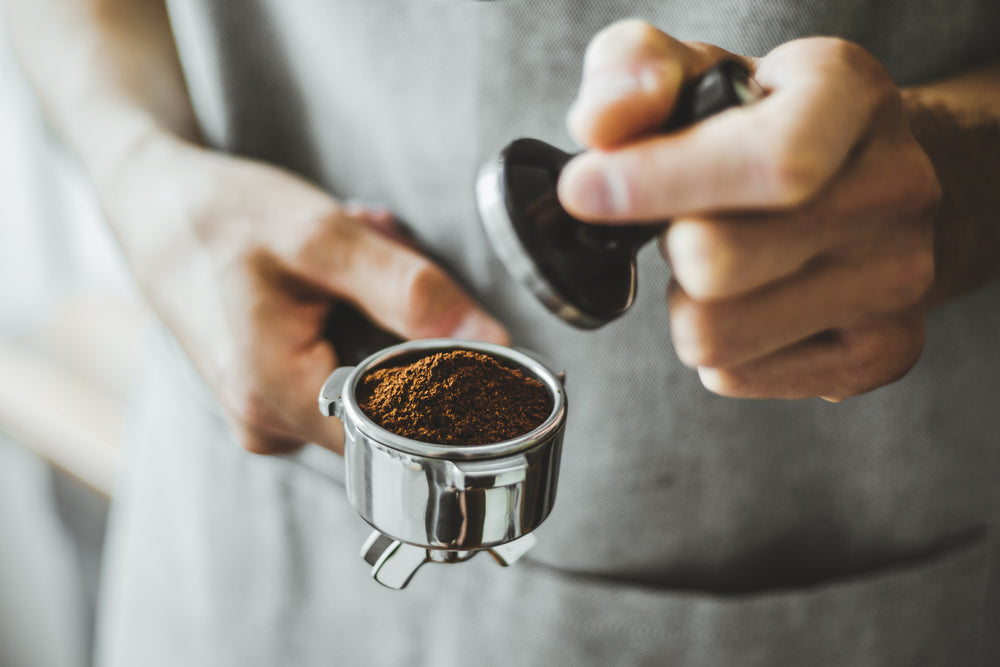
A Guide On Coffee Tamping Do's And Don'ts: How To Perfect Your Tamp
The main idea behind pulling a shot of espresso is to have the nearly boiling water extract coffee oils that bear the flavours. To achieve this, the puck should provide ample resistance to the high-pressure hot water without experiencing channelling. This is where even tamping comes into play.
It's imperative for you to consistently and evenly tamp the coffee grinds to pull shots that are flavourful, creamy, and rich in texture. On the other hand, getting an even and consistently tamp is difficult. The importance and complexity of tamping can be intimidating for many, especially novice baristas. However, don't let that deter you from trying.
In this article, we'll delve into the do's and don'ts of tamping. Read on for a complete guide on how to perfect your tamp.
What Is Coffee Tamping?
Tamping is the process of compacting coffee grounds in the portafilter of an espresso machine before brewing. This is typically done with a tamper, which is a small, cylindrical tool. The design and shape of the portafilter makes it easy to evenly spread the pressure across the coffee grounds creating a dense, even layer.
The compacted coffee grounds resist the high-pressure water, making it hard for water to pass through. Consequently, the water has to saturate the grounds and extract the coffee oil, flavours, and aromas that give espresso its rich taste and bold texture.
Another goal of tamping is to create an even surface on top of the coffee grounds. An even surface ensures water flows through the grounds evenly, leading to consistent coffee flavours and aroma extraction. An uneven surface almost always results in uneven extraction and bitter espresso. The compact layer of grounds and the even surface also help to prevent channelling, which occurs when water flows through a path of least resistance instead of evenly saturating through the coffee grounds.
Benefits Of Tamping Coffee
The notable benefits of tamping your coffee include the following:
- The compression resulting from tamping ensures even and consistent extraction of coffee oils, flavours, and aromas.
- Tamping negates channelling, where water takes the path of least resistance through the coffee grounds.
How To Tamp Coffee: Step-By-Step Instructions
Step 1: Prepare The Coffee Grinds In Your Portafilter
Grind your roasted coffee beans into your portafilter handle. Fill the portafilter basket up to just above the rim. Start to level the bed of coffee grinds by running your index finger across the top of the portafilter.
Give the portafilter a light tap on the side to spread the grinds into any existing voids and reduce the spaces between the grinds. Give your portafilter a light tap on your tamping mat to create a level spread of grinds.
Step 2: Mind Your Posture
Part of perfecting your tamping technique is using the correct posture. To this end, place your portafilter on your tamping mat and ensure it’s level. If your portafilter has a spout, place the edges of the portafilter on the edge of your counter.
Assume a posture where your tamping-side hip faces the counter. Bend your elbow 90 degrees and keep your wrist straight. Grab the tamper and hold it with your index and thumb, akin to holding a doorknob. This posture helps you maintain excellent control while tamping. Additionally, the posture protects your wrist from a repetitive stress injury.
Step 3: First Round Of Tamping - Apply Light Pressure
The first round only requires light pressure. While you'll be compacting the grounds, the main aim of the first round of compacting is to achieve a flat surface. Hence, the essential goal at this stage is getting a flat puck.
To achieve your goal, you should apply about 15 pounds of tamping pressure, sufficient to form a puck shape. The best way to know that you've used the amount of pressure is to stand on your bathroom scale and track the weight decrease until you reach 15 pounds.

Step 4: Second Round Of Tamping - Apply More Pressure
You should apply ample pressure in the second round of tamping to compact the puck to the right consistency. To this end, you should apply up to 30 pounds of pressure. However, you can get your tamping right with just 20 pounds of force. Regardless of your pressure level, always ensure your tamp is perfectly level and consistent.
Step 5: Inspect The Puck For A Flat Level Surface And Polish The Surface
Ensure your puck has no loose spots or gaps around the coffee grounds. If everything is okay, twist the tamper 720°(twice) while applying pressure to yield a smooth and even surface on the puck. In other words, 'polish' the puck.
Step 6: Clean Up All Loose Coffee Grounds
Finally, clean off any excess coffee grounds, especially around the edges of the portafilter. You are ready to take the portafilter to the espresso machine and brew coffee.
Do's And Don'ts In Coffee Tamping
Do's
- Be meticulous about keeping the grounds level during tamping.
- Clean any coffee grounds particles from your tamper.
- Always use the right tamper size.
Don'ts
- Don't exact your wrist. You risk injury by applying force from your wrist.
- Don't exceed the recommended 30 pounds of force, as you risk channelling.
Final Thoughts
The quality of your espresso, its aroma, and flavours has to do with your consistency in tamping. If you get the basics of tamping right, you're one step closer to brewing the perfect shot of espresso.
Buy Coffee Tampers At Dolo website!
As you can appreciate, the tools you use will influence how well you can tamp your coffee. You'll have a difficult time perfecting your tamping technique if you use inappropriate tampers. You must ensure your tamper is compatible with your portafilter. It should also be comfortable, ergonomic and durable.
Here at Dolo Coffee Supplies, we have a myriad of tampers available. We have the perfect product for you, whether you're a novice trying your hands on espresso brewing or an experienced barista looking to add a new set of portafilter and tamper to your collection.
Please give us a call at +61 7 5576 2459 to know more or leave an enquiry.
